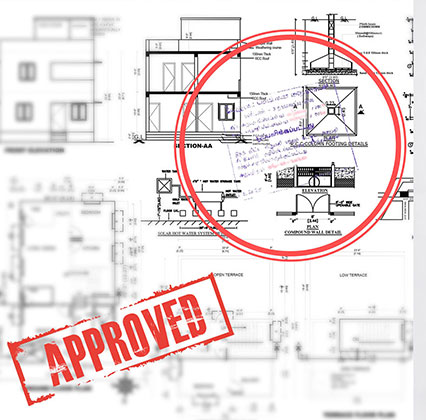The applicant is required to register on the citizen portal of the local governing body. Subsequently, the application form must include details about the site for which planning permission and a building permit are being requested.
Additionally, the applicant is to select a registered architect or registered engineer. This selection allows the application details to be transmitted to the chosen professional, who will then prepare the necessary drawings and submit the planning permission and building permit application for approval.
The applicant’s registration for planning permission and building permit approval is forwarded to the portal of the selected registered architect or engineer for further processing. Upon receiving the applicant’s request, the registered architect or engineer conducts a site visit, collects the required documents from the applicant, prepares the drawings, and submits them online for automated scrutiny to ensure compliance with Development Regulations and Building Rules.
The registered architect or engineer records the registration details, inspection documents, and Auto-DCR details online. The application fee is to be paid online by the registered architect or engineer for the application’s acceptance.
The application submitted by the registered architect or engineer receives a unique application number, against which all online documents are received in the Assistant Executive Engineer’s (AEE) portal for subsequent processing. The AEE schedules a site visit within 7 days from the application’s receipt date, and this date is communicated to the licensed surveyor and applicant through SMS and email.
During the site inspection, the online plan is verified for the following:
- Site boundary measurements
- Access to the public road
- Measurement of road width
- Assessment of the plot’s surroundings to determine if it abuts any drains, channels, water bodies, etc.
- Zoning of the land
After the site visit on the scheduled date, the AEE submits the inspection report online within 48 hours, which can be viewed by the applicant and the registered architect or engineer.
Following the site inspection, the AEE reviews the documents submitted online. If the plan and information provided by the applicant are deemed insufficient for satisfactory application processing, the AEE has 15 days from the date of plan or application receipt to request any additional necessary particulars and details. This request is communicated via SMS and email. The applicant or registered architect/engineer must upload the requested documents online within 15 days; otherwise, the application will proceed with the available documents.
If the enclosed documents suffice for approval, the planning permission (if applicable) and building permit application are submitted for approval to the Executive Engineer (EE).
Should the EE require further clarification or documents, the application will be sent back to the AEE through the portal.
Upon receiving notice of documents or clarification needed, the AEE informs the applicant of the requirements. Following the receipt of the required documents or clarification from the applicant or the registered architect/engineer, the application is submitted to the EE for approval.
If the documents and plan meet the EE’s requirements, the application is approved online, and a “Demand Advice” is generated. The applicant is notified through SMS and email, and they are requested to make the payment either online or by way of a Demand Draft.
The applicant proceeds to make the payment online.
- The AEE verifies the payment completed by the applicant and forwards the application to the Executive Engineer.
- The EE confirms the verified fees.
- The EE generates the final building permit online. The applicant is informed of the approval through SMS and email, and they are able to download the certificate online.
Types of Buildings Requiring Approval
There are various categories of buildings, each with distinct criteria:
- Residential Buildings:
– Stilt + 3 floors or Ground floor + two floors
– Maximum height of 12 meters
– Up to 16 dwelling units within a 10,000 sq.ft area
- Commercial Buildings:
– Stilt + 3 floors or Ground floor + two floors
– Maximum height of 12 meters
– Maximum built-up area of 300 sq.m
- Industries (Cottage Industry/Green Industry/Orange Industry):
– Maximum height of 18.30 meters
– Unlimited built-up area
- Institutional Buildings:
– Maximum height of 18.30 meters
– Unlimited built-up area
- High Rise Buildings:
– Any building exceeding a height of 18.30 meters
Requirements for Building Plan Approval for Non-High Rise Buildings (Not Exceeding 18.3m in Height):
-
- Duly filled-in Application for permission for building (Form-B as per Annexure-II of TNCDBR, 2019).
- A completed Form of undertaking (Form-C as per Annexure-III of TNCDBR, 2019).
- Self-attested copies of documents (sale deed/lease deed/power of attorney) by the applicant.
– Note: In the case of unapproved sub-division, copies of documents, including connected parent documents, are required. For urban areas (corporation, municipality, town panchayat), documents involving transactions since 1.1.1980 must be provided.
-
- An affidavit of undertaking specifying certain details, particularly for lands with survey numbers other than Town Survey Number.
- Copy of revenue records, including Field Measurement Book (FMB)/Town Survey sketch, Patta, ‘A’ Register copy, Permanent Land Record (PLR)/Town Survey Land Record (TSLR) in the owner’s name.
- Up-to-date Encumbrance Certificate (EC) in the original, obtained within 30 days of application submission. For unapproved sub-divisions in urban areas (corporation, municipality, town panchayat), ECs with transactions since 1.1.1980 must be submitted.
- FMB/Town Survey sketch, Adangal/’A’ register extract/TSLR for the access road.
– Note: In cases where the qualifying road is not incorporated in the FMB sketch, a road width certificate is required.
- NOC from the Railways department if the site is within 30m from Railway property boundary.
- NOC from TANGEDCO if the construction violates buffer norms for LT and HT power lines.
- An affidavit of undertaking about the availability of a piped water supply facility when building within 30m of the boundary of a burial/cremation ground.
- An affidavit of undertaking about the actual availability of underground drainage facilities, if seeking exemption from providing sewage treatment plants (STP).
- No structure can be permitted within 500m of a quarry/stone crusher. If claimed as abandoned, a certificate from the local body or licensing authority is needed.
- Legal opinion by a qualified professional regarding land ownership.
- An affidavit of undertaking about land ownership, specifying the extent of each survey number.
- Details of the registered professional for the project and a copy of their registration certificate, depending on the project’s specifications.
- NOC from the Fire Service department for public buildings, commercial complexes/malls, cinemas, kalyana mandapam, community halls, industries, and warehouses where inflammable materials are handled.
- Various plans and provisions as prescribed in TNCDBR, 2019, including key plans, topo plans, site plans, building plans, rainwater harvesting provisions, and solar energy capture provisions.
- NOC from relevant authorities if the site falls under specific areas, such as regulated areas, sterilized zones, coastal regulation zones, civil aviation and defense area regulation zones.
- Additional requirements for areas under the Hill Area Conservation Authority (HACA), including NOCs from various relevant departments, site inspection remarks, and contour plans.
- A project report detailing raw materials, manufacturing processes, the number of employees, and HP requirements for industries.
- A copy of the latest property tax or vacant land tax receipt.
Please note that high rise buildings and industries have additional documentation requirements, which can be found in the comprehensive list provided.
Completion Certificate for Services
For all buildings, with the exception of residential buildings not exceeding a height of 12 meters, with no more than 3 dwelling units or a built-up area of 750 sq.m, and for all types of industrial buildings, the applicant, owner, power of attorney holder, registered developer, or any other individual acquiring an interest must submit a completion report. This report is required to obtain a Completion Certificate from the competent authority that originally issued the Planning Permit. The Completion Certificate serves as verification that the construction aligns with the approved plan.
Service connections, such as electric power and water supply sewerage connections, will only be provided to these buildings by the respective service providers once the Completion Certificate is presented.



